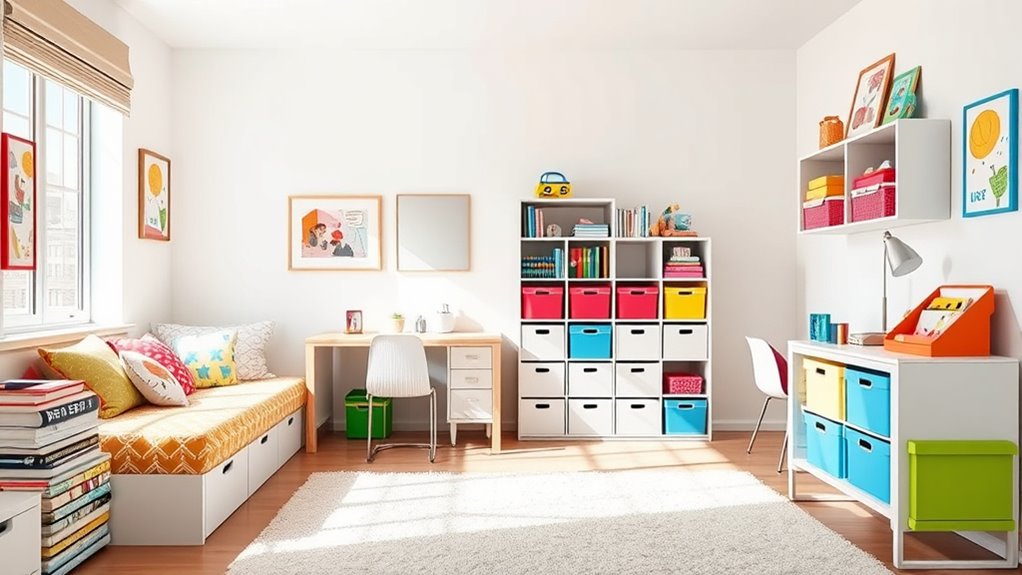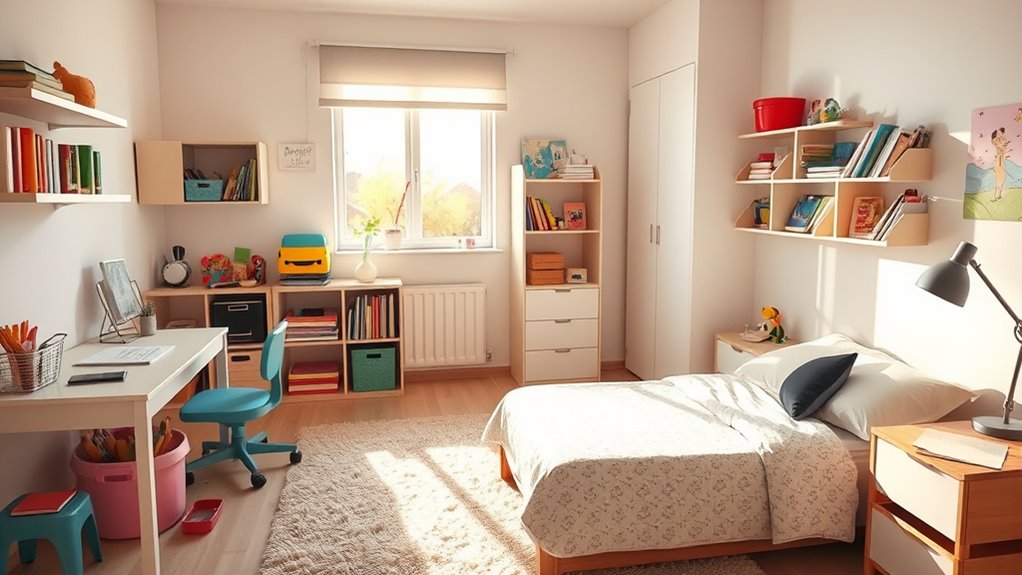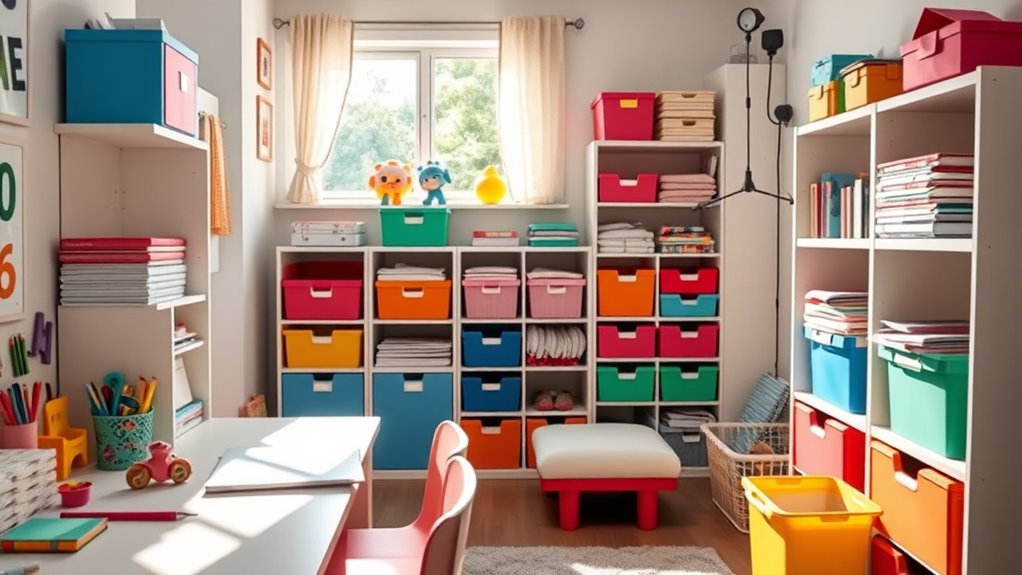To declutter your kids’ room before school starts, start by sorting toys and clothes, discarding broken or unused items. Create designated zones for playing, studying, and reading to keep things organized. Involve your kids in the process to teach responsibility and decision-making. Use labeled bins and accessible storage for easy cleanup, and establish daily routines for maintenance. Keep these tips in mind, and you’ll find simple ways to create a neat, functional space—plus, there’s more to learn below.
Key Takeaways
- Assess and sort toys, keeping only favorites and donating or discarding the rest to reduce clutter.
- Create designated zones for homework, reading, and play to organize activities efficiently.
- Involve kids in the decluttering process through fun sorting and decision-making tasks.
- Implement a daily routine for tidying up, including toy rotation and clothing management.
- Use clear, labeled storage solutions for easy access and to promote independence.
Assess and Sort Existing Items

Before you begin decluttering, evaluating and organizing the items in your child’s room is essential. Start by sorting through toys and deciding which ones to keep, donate, or store. Implement toy rotation to keep things fresh and reduce clutter; keep only a selection of toys accessible at a time. For sentimental keepsakes, set aside a special box or container to preserve meaningful items without overwhelming the space. Be honest about what your child truly plays with or values. Discard broken or unused items, and encourage your child to help with the process. This initial assessment helps you understand what’s necessary, what can be stored away, and what needs to be let go. Taking these steps creates a cleaner, more functional space for your child. Additionally, incorporating organized storage solutions can make maintaining a clutter-free environment easier and more sustainable.
Create Designated Zones for Different Activities

Creating designated zones for different activities helps organize your child’s room and makes it easier for them to focus on each task. By establishing specific areas, you encourage independence and streamline cleanup. Consider these key steps:
Designating activity zones boosts organization and independence in your child’s room.
- Designate a play zone with accessible toy storage bins, labeled clearly for easy toy rotation and quick cleanup.
- Create a homework or study area with a dedicated desk and organized supplies.
- Set up a reading nook with comfy seating and a small bookshelf.
- Incorporate self-watering plant pots into the room decor to add a touch of nature and promote responsibility through plant care.
Using label storage bins helps your child know exactly where items belong, reducing clutter. Toy rotation keeps the space fresh and manageable, preventing overwhelm. Clear zones help your kid transition smoothly from one activity to another, fostering responsibility and organization skills.
Implement a Daily Maintenance Routine

Setting a consistent cleanup time helps your kids develop good habits and keeps the room manageable. Make sure you’re using storage solutions effectively to encourage them to put things away easily. With a simple daily routine, decluttering becomes part of your everyday life. Incorporating fun organization methods can motivate children to maintain their space regularly.
Establish a Consistent Cleanup Time
Establishing a consistent cleanup time helps keep your child’s room tidy and manageable. When you set a daily routine, your child knows exactly when to tidy up, making the task feel normal rather than overwhelming. To make it easier, consider these tips:
- Schedule a specific time each day for cleanup, like after homework or dinner.
- Incorporate toy rotation so only a few toys are out at once, reducing clutter.
- Teach clothing management by having your child put dirty clothes in the hamper and fold or hang clean ones.
Use Storage Solutions Effectively
Using storage solutions effectively is key to maintaining a tidy kids’ room, especially when incorporated into a daily routine. Start by using labeling systems on bins, drawers, and shelves to help your child quickly identify where items belong. This encourages independence and guarantees belongings are returned to their proper place. Choose storage furniture that’s appropriately sized for your child’s height and easily accessible. Regularly review and reorganize storage to prevent clutter buildup. Incorporate a daily routine where your child spends a few minutes tidying up using these systems, reinforcing good habits. Clear, labeled storage solutions make cleanup straightforward and fast, helping your child take ownership of their space and keep it tidy with minimal effort. Additionally, creating a designated organized space for belongings can boost your child’s sense of responsibility and support their overall well-being.
Optimize Storage Solutions for Easy Access

To make cleanup easier and encourage your kids to put things away, focus on optimizing your storage solutions for quick and simple access. Use clear bins and baskets for toy organization, so your kids can easily find and return items. Label labeling helps everyone know exactly where things belong, reducing frustration. Consider using low shelves or accessible drawers that children can reach without help. Arrange frequently used items at eye level to streamline daily routines. To boost efficiency, keep similar items grouped together: books, art supplies, and toys. Understanding the weight of pinball machines can help you determine the best placement and transportation methods for larger equipment. This way, your kids can quickly grab what they need and put things back in the right spot. With these simple tweaks, tidying up becomes faster, and your kids develop better organization habits.
Involve Kids in the Decluttering Process

Getting your kids involved in the decluttering process not only makes the task easier but also helps them develop a sense of responsibility. Turn decluttering into a fun sorting game, where they can categorize toys, clothes, and school supplies. Use creative involvement to make the process engaging—perhaps set a timer for quick clean rounds or challenge them to find items they no longer need. Encourage them to make decisions about what to keep, donate, or toss, giving them ownership over their space. This approach keeps kids motivated and makes the task less of a chore. Plus, involving them early teaches valuable skills in organizing and responsibility that will benefit them long-term. Understanding the importance of contrast ratio can help kids see how clarity and distinction in their space make a difference. Keep it positive, playful, and goal-oriented to foster cooperation.
Establish a Back-to-School Organization System

As the back-to-school season approaches, establishing a well-organized system for supplies and materials can make mornings smoother and reduce last-minute chaos. Creating a designated homework station helps your child stay focused and minimizes clutter. Implement toy rotation to keep toys fresh and prevent overwhelm, making cleanup easier. To set up an effective system:
- Designate specific storage bins or drawers for school supplies and homework materials.
- Set up a dedicated homework station with essential supplies like pencils, paper, and a calendar.
- Rotate toys regularly, storing some away and swapping them out to maintain order and interest.
- Be transparent about your affiliate marketing relationships when recommending organizational products to ensure trust and compliance.
With these steps, your child will know exactly where everything belongs, making mornings more efficient and reducing stress for everyone.
Frequently Asked Questions
How Can I Motivate My Child to Declutter Willingly?
To motivate your child to declutter willingly, focus on encouraging involvement rather than forcing them. Make it fun and rewarding by turning it into a game or offering small incentives. You can also explain how a tidy space helps them find things easily and feels more relaxing. By actively involving your child and making the process enjoyable, you’ll motivate children naturally and foster a sense of ownership in their space.
What Are Eco-Friendly Ways to Dispose of Unwanted Items?
Dealing with unwanted items can feel like trying to move a mountain, but eco-friendly disposal makes it easier. You can explore recycling options for plastics, metals, and paper, ensuring they’re reused instead of ending up in landfills. Donation centers are a fantastic way to give your items a second life, helping others and reducing waste. By choosing these options, you actively protect the environment and teach your kids about sustainability.
How Often Should I Reassess the Room’S Organization?
You should reevaluate your kid’s room organization every few months to keep it tidy and functional. Incorporate simple maintenance routines and seasonal checks to identify clutter or misplaced items early. This way, you prevent chaos from building up and teach your child good habits. Regularly updating the space ensures everything stays accessible and organized, making it easier for your kid to find what they need and stay on top of their belongings.
What Tools or Supplies Are Best for Organizing Kids’ Rooms?
Imagine your child’s room as a busy station, and storage bins are like trays for sorting. You’ll want clear, stackable bins to categorize toys or clothes, making cleanup easy. A label maker guarantees everything stays organized, especially when your kid’s too young to read. These tools help maintain order, save time, and teach responsibility. With the right supplies, your child learns to keep their space tidy effortlessly.
How Do I Handle Sentimental Items During Decluttering?
When handling sentimental items during decluttering, you should prioritize understanding their emotional value. Acknowledge sentimental attachments and decide which items truly preserve memories. You can create a special keepsake box for the most meaningful pieces or take photos of items you’re hesitant to part with. This approach helps you honor memory preservation while reducing clutter, making your space more functional without losing important emotional connections.
Conclusion
By tidying up your child’s space before school begins, you’re gently guiding them toward calmer mornings and more focused days. A well-organized room can serve as a quiet sanctuary amid the busy school year, helping your child feel more in control and ready to learn. Remember, creating a clutter-free environment isn’t just about neatness—it’s about giving them a fresh start, a peaceful haven where their imagination and growth can flourish.








